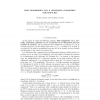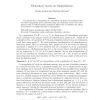DCG
2006
13 years 4 months ago
2006
We propose an algorithm to compute a conforming Delaunay mesh of a bounded domain specified by a piecewise linear complex. Arbitrarily small input angles are allowed, and the inpu...
DCG
2006
13 years 4 months ago
2006
DCG
2006
13 years 4 months ago
2006
Abstract. Hyperbolic area is characterized as the unique continuous isometry invariant simple valuation on convex polygons in H2 . We then show that continuous isometry invariant s...
DCG
2006
13 years 4 months ago
2006
The maximal area of a polygon with n = 2m edges and unit diameter is not known when m 5, nor is the maximal perimeter of a convex polygon with n = 2m edges and unit diameter known...
DCG
2006
13 years 4 months ago
2006
Abstract. We show that there exist k-neighborly centrally symmetric ddimensional polytopes with 2(n + d) vertices, where k(d, n) = ,, d 1 + log((d + n)/d)
DCG
2006
13 years 4 months ago
2006
This paper sheds a new light on the split decomposition theory and T-theory from the viewpoint of convex analysis and polyhedral geometry. By regarding finite metrics as discrete ...
DCG
2006
13 years 4 months ago
2006
DCG
2006
13 years 4 months ago
2006
DCG
2006
13 years 4 months ago
2006
We show, with an elementary proof, that the number of halving simplices in a set of n points in R4 in general position is O(n4-2/45). This improves the previous bound of O(n4-1/13...
DCG
2006
13 years 4 months ago
2006
It is proved that a triangulation of a polyhedron can always be transformed into any other triangulation of the polyhedron using only elementary moves. One consequence is that an ...


